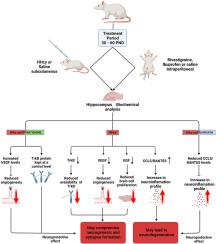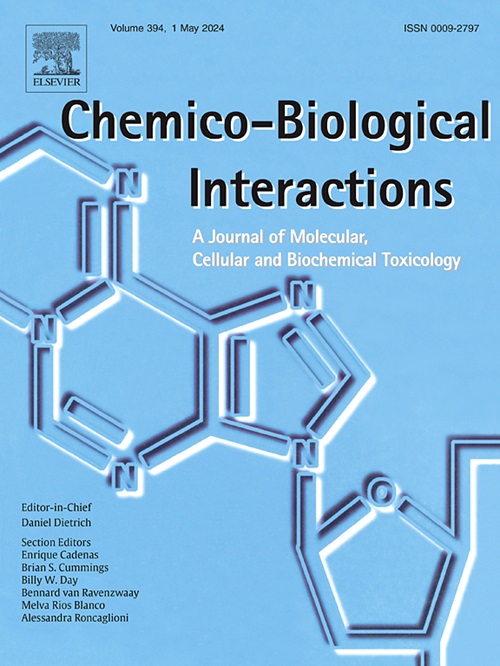Homocysteine decreases VEGF, EGF, and TrkB levels and increases CCL5/RANTES in the hippocampus: Neuroprotective effects of rivastigmine and ibuprofen
IF 4.7
2区 医学
Q1 BIOCHEMISTRY & MOLECULAR BIOLOGY
引用次数: 0
Abstract
Homocysteine (Hcy) is produced through methionine transmethylation. Elevated Hcy levels are termed Hyperhomocysteinemia (HHcy) and represent a risk factor for neurodegenerative conditions such as Alzheimer's disease. This study aimed to explore the impact of mild HHcy and the neuroprotective effects of ibuprofen and rivastigmine via immunohistochemical analysis of glial markers (Iba-1 and GFAP). Additionally, we assessed levels of vascular endothelial growth factor (VEGF), epidermal growth factor (EGF), chemokine ligand 5 (CCL5/RANTES), CX3C chemokine ligand 1 (CX3CL1), and the NGF/p75NTR/tropomyosin kinase B (TrkB) pathway in the hippocampus of adult rats. Mild chronic HHcy was induced chemically in Wistar rats by subcutaneous administration of Hcy (4 mg/kg body weight) twice daily for 30 days. Rivastigmine (0.5 mg/kg) and ibuprofen (40 mg/kg) were administered intraperitoneally once daily. Results revealed elevated levels of CCL5/RANTES and reduced levels of VEGF, EGF, and TrkB in the hippocampus of HHcy-exposed rats. Rivastigmine mitigated the neurotoxic effects of HHcy by increasing TrkB and VEGF levels. Conversely, ibuprofen attenuated CCL5/RANTES levels against the neurotoxicity of HHcy, significantly reducing this chemokine's levels. HHcy-induced neurochemical impairment in the hippocampus may jeopardize neurogenesis, synapse formation, axonal transport, and inflammatory balance, leading to neurodegeneration. Treatments with rivastigmine and ibuprofen alleviated some of these detrimental effects. Reversing HHcy-induced damage through these compounds could serve as a potential neuroprotective strategy against brain damage.

同型半胱氨酸会降低海马中血管内皮生长因子、表皮生长因子和 TrkB 的水平,并增加 CCL5/RANTES:利伐斯的明和布洛芬的神经保护作用。
同型半胱氨酸(Hcy)是通过蛋氨酸转甲基化产生的。Hcy 水平升高被称为高同型半胱氨酸血症(HHcy),是阿尔茨海默病等神经退行性疾病的危险因素。本研究旨在通过对神经胶质标记物(Iba-1 和 GFAP)的免疫组化分析,探讨轻度 HHcy 的影响以及布洛芬和利伐斯的明的神经保护作用。此外,我们还评估了成年大鼠海马中血管内皮生长因子(VEGF)、表皮生长因子(EGF)、趋化因子配体 5(CCL5/RANTES)、CX3C 趋化因子配体 1(CX3CL1)和 NGF/p75NTR/托肌丝激酶 B(TrkB)通路的水平。通过皮下注射 Hcy(4 毫克/千克体重)给 Wistar 大鼠造成轻度慢性 HHcy,每天两次,连续 30 天。每天腹腔注射一次利伐斯的明(0.5 毫克/千克)和布洛芬(40 毫克/千克)。结果显示,暴露于 HHcy 的大鼠海马中 CCL5/RANTES 水平升高,VEGF、EGF 和 TrkB 水平降低。利伐斯的明通过提高 TrkB 和血管内皮生长因子的水平,减轻了 HHcy 的神经毒性作用。相反,布洛芬可降低 CCL5/RANTES 的水平,从而对抗 HHcy 的神经毒性,并显著降低这种趋化因子的水平。HHcy诱导的海马神经化学损伤可能会损害神经发生、突触形成、轴突运输和炎症平衡,从而导致神经退行性变。使用利伐斯的明和布洛芬治疗可减轻其中一些有害影响。通过这些化合物来逆转 HHcy 诱导的损伤,可以作为一种潜在的神经保护策略来防止脑损伤。
本文章由计算机程序翻译,如有差异,请以英文原文为准。
求助全文
约1分钟内获得全文
求助全文
来源期刊
CiteScore
7.70
自引率
3.90%
发文量
410
审稿时长
36 days
期刊介绍:
Chemico-Biological Interactions publishes research reports and review articles that examine the molecular, cellular, and/or biochemical basis of toxicologically relevant outcomes. Special emphasis is placed on toxicological mechanisms associated with interactions between chemicals and biological systems. Outcomes may include all traditional endpoints caused by synthetic or naturally occurring chemicals, both in vivo and in vitro. Endpoints of interest include, but are not limited to carcinogenesis, mutagenesis, respiratory toxicology, neurotoxicology, reproductive and developmental toxicology, and immunotoxicology.

 求助内容:
求助内容: 应助结果提醒方式:
应助结果提醒方式:


